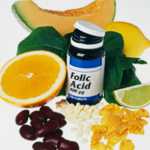Natural Folic Acid Foods for Pregnancy
 Folic acid, also called folate, is a form of vitamin B specifically vitamin B9 and is found in natural food like pulses and also in green vegetables. Folic acid is needed by the human body to produce red blood cells and DNA. For healthy development of the brain and nervous system Folic acid is necessary. It also helps in the formation of spinal fluid.
Folic acid, also called folate, is a form of vitamin B specifically vitamin B9 and is found in natural food like pulses and also in green vegetables. Folic acid is needed by the human body to produce red blood cells and DNA. For healthy development of the brain and nervous system Folic acid is necessary. It also helps in the formation of spinal fluid.
Importance of Folic Acid
Folic acid is necessary for all humans. It is especially necessary for the women who are planning pregnancy and intend to have a baby. Those planning conception should start a regular intake of 400 micrograms of folic acid daily. This should continue even during early pregnancy. As this intake will prevent the child from developing neural tube defect, which is a defect in the child existing at the time of the birth resulting in incomplete development of brain and spinal cord.
In addition to helping reduce the chances of birth defect in the baby, the chances of miscarriage are also reduced. The symptoms of spinal and brain defects start to appear in the child in the first 28 days after the pregnancy starts. Often by this time the mother to be is not even aware of the fact that she is pregnant.
In ideal circumstances 400 micrograms of folic acid should be started three months before conception and carried on along with other prescribed supplements during the full period of pregnancy and six months thereafter when the child is being breastfed. In case of the women who have delivered a child with NTD the doctors prescribe intake of even higher dose of folic acid to prevent the risk in the subsequent child.
Natural Folic Acid foods in pregnancy
Though it is always better to take folic acid in the natural form from pulses and green leafy vegetables but the doctors always recommend that the pregnant woman take supplements as the risk of inadequate intake is very high for the baby to be born. Some of the items of food which are rich in folic acid and also good for the health of the mother and child are:
- Orange contains 55 micrograms (mcg)
- Hardboiled egg contains 22 mcg
- Papaya of medium size contains 115 mcg
- Chickpeas ½ cup contains 140 mcg
- Cooked spinach ½ cup contains 130 mcg
- 3/4 cup of cooked rice contains 60 mcg
- One cup tomato juice contains 50 mcg
- ½ cup cooked lentils contain 175 mcg
- 4 tea spoons of black eyed beans contain 220 mcg
In addition to the above, kidney beans, noodles bran flakes, wheat germ are all rich in folic acid. Leafy green vegetables, radish, peas, corn, green pepper, mustard and lady finger are also rich sources of folic acid. Nuts, soya beans and many fruits are also rich source of folic acid.
Folic acid is a delicate ingredient of food and gets destroyed easily while cooking. When you are cooking something, ensure that the food stuff is boiled for the minimum possible time and cooking is done with the pan covered with a lid. Steamed, micro waved or raw vegetables are the best option.
Deficiency Symptoms
The symptoms of folic acid deficiency are like those of an anaemic patient. There is a feeling of weakness, fatigue, nausea, digestive disorder etc. The best option is to discuss the food chart of a pregnant woman with the dietician.